Analyzing Apple’s A8 SoC: PowerVR GX6450 & More
by Ryan Smith on September 10, 2014 5:00 AM EST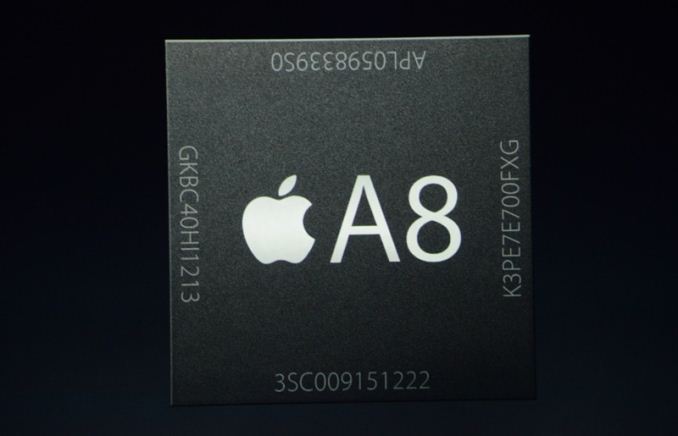
With their iPhone keynote behind them, Apple has begun updating some of their developer documentation for iOS to account for the new phone. This of course is always a fun time for tech punditry, as those updates will often include information on the hardware differences in the platform, and explain to developers the various features that different generations of hardware can offer developers.
To that end we have compiled a short analysis of the A8 SoC based on these documents and other sources. And we believe that at this point we have a solid idea of the configuration of Apple's latest SoC.
| Apple SoC Specifications | ||||||
| Apple A6 | Apple A7 | Apple A8 | ||||
| CPU | Swift @ 1.3GHz(x2) | Cyclone @ 1.3GHz (x2) | Enhanced Cyclone @ 1.4GHz (x2)? | |||
| GPU | PVR SGX543MP3 | PVR G6430 | PVR GX6650 | |||
| RAM | 1GB LPDDR2 | 1GB LPDDR3 | 1GB LPDDR3? | |||
A8’s GPU: Imagination PowerVR Series6XT GX6650 GX6450
On the GPU front this year appears to be especially bountiful. After being tipped to an update for Apple’s Metal Programming Guide, we can now infer with near certainty that we know what the A8 GPU is.
New to this edition of the Metal Programming Guide is a so-called iOS_GPUFamily2, which joins the existing iOS_GPUFamily1. We already know that the iOS_GPUFamily1 is based around Imagination’s PowerVR Series 6 G6430 GPU, so the real question is what does iOS_GPUFamily2 do that requires a separate family? The answer as it turns out is ASTC, the next generation texture compression format is being adopted by GPU vendors over the next year or so.
Imagination’s PowerVR Series6 family of GPUs predates ASTC and as a result iOS_GPUFamily1 does not support it. However we know that Imagination added support for it in their Series6XT designs, which were announced at CES 2014. Coupled with the fact that Apple’s documentation supports the idea that all of their GPUs are still TDBR (and thus PowerVR), this means that the GPU in the A8 must be a Series6XT GPU in order for ASTC support to be present.
This leaves the question of which of Imagination’s 4 Series6XT Apple is using. Imagination offers a pair of 2 core designs, a 4 core design (GX6450), and a 6 core design (GX6650). Considering that Apple was already using a 4 core design in A7, we can safely rule out the 2 core designs. That leaves us with GX6450 and GX6650, and to further select between those options we turn to Apple’s A8 performance estimates.
| Apple SoC Evolution | |||||
| CPU Perf | GPU Perf | Die Size | Transistors | Process | |
| A5 | ~13x | ~20x | 122m2 | <1B | 45nm |
| A6 | ~26x | ~34x | 97mm2 | <1B | 32nm |
| A7 | 40x | 56x | 102mm2 | >1B | 28nm |
| A8 | 50x | 84x | 89mm2 | ~2B | 20nm |
A8 is said to offer 84x the GPU performance of the iPhone 1, while last year Apple stated that the A7 offered 56x the iPhone 1’s performance. As a result we can accurately infer that the A8 must be 1.5x faster than the A7, a nice round number that makes it easier to determine with GPU Apple is using. Given Apple’s conservative stance on clockspeeds for power purposes and the die space gains from the 20nm process, accounting for a 50% performance upgrade is easily done by replacing a 4 core G6430 with the 6 core GX6650. At equal clockspeeds the GX6650 should be 50% faster on paper (matching Apple’s paper numbers), leading us to strongly believe that the A8 is utilizing a PowerVR Series6XT GX6650 GPU.
Once the iPhone 6 is out and Chipworks can photograph the SoC, this should be easy to confirm. If Apple is using a GX6650 then the die size of the GPU portion of the A8 should be very similar to the die size of the GPU portion of the A7. Otherwise if it is the 4 core GX6450, then Apple should see significant die size savings from using a 20nm fabrication process.
Update: The Chipworks die shots have confirmed that there are only 4 GPU cores present, not 6. So our earlier speculation was wrong; A8 is powered by GX6450, not GX6650
A8’s CPU: A Tweaked Cyclone?
Though we typically avoid rumors and leaks due to their high unreliability, after today’s presentation by Apple we have just enough information on A8’s CPU performance to go through the leak pile and start picking at leak. From that pile there is one leak in particular that catches our eye due to the fact that it matches Apple’s own statements.
On Monday night a supposed Geekbench 3 score of the iPhone 6 was posted. In this leak the iPhone 6 was listed as having a single-core score of 1633 points and a multi-core score of 2920 points. Curiously, these values are almost exactly 25% greater than the Geekbench 3 scores for the iPhone 5S (A7), which are 1305 points and 2347 points respectively.
The fact that ties all of this data together is that in their iPhone 6 presentation, Apple informed viewers that the iPhone 6 is 25% faster than the iPhone 5S. This data was later backed up with their latest CPU performance graph, which put the iPhone 6 at a score of 50x versus a score of 40x for the iPhone 5S.
Given Apple’s data, it looks increasingly likely that the leaked Geekbench 3 results for the iPhone 6 are in fact legitimate. The data leaked matches Apple’s own performance estimates, and in fact does so very well.
In which case we can infer a couple of points about the A8’s CPU, starting with the clockspeed. Given no other reason to doubt this data at the moment and given Apple’s preference for low clocked SoCs, the 1.4GHz reading appears legitimate. In which case this would be a 100MHz increase over the 1.3GHz A7 found in the iPhone 5S.
However the fact that it’s a 100MHz increase also means that clockspeeds alone cannot account for the full 25% performance gain that Apple is promoting and that these Geekbench results are reporting, as 1.4GHz is only a roughly 8% clockspeed increase over 1.3GHz. This in turn means that there must be more going on under the hood to improve the A8’s CPU performance other than clockspeed alone, which rules out a straight-up reuse of Apple’s Cyclone CPU.
Since Apple already had a solid ARMv8 architecture with Cyclone, there’s no reason to believe that they have thrown out Cyclone so soon. However this does strongly suggest that Apple has made some unknown revisions to Cyclone to further boost its single-threaded (Instruction Level Parallelism) performance. What those tweaks are remain to be seen as we would need to be able to benchmark the A8 in depth to even try to determine what Apple has changed, but for the moment it looks like we’re looking at an enhanced or otherwise significantly optimized version of Cyclone. And given Apple’s already high ILP, squeezing out another 16% or so would be a significant accomplishment at this time, especially for only a year’s turnaround.
1GB of RAM
Last but not least, the apparent validity of the Geekbench 3 leak means that one last piece of information on the A8 can apparently be confirmed: the earlier rumors about it being paired with 1GB of RAM are true. Unfortunately Apple’s official product image of the A8 is of no help here – it’s clearly a doctored version of the A7 image based on the product numbers attached – but this information is consistentwith earlier rumors based on leaked images of the real A8, which had also suggested the SoC contained 1GB of RAM. Again this is based on what we believe is a sound assumption that the Geekbench 3 leak is accurate since it so closely matches Apple’s own CPU performance estimates, but at this point we don’t have any substantial reason to doubt the data.
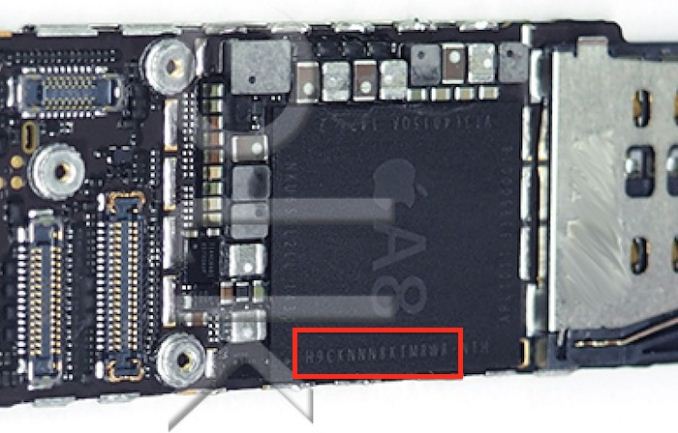
Image Courtesy Macrumors
The good news is that this is going to be the easiest aspect of the iPhone 6 to confirm, since diagnostic apps will be able to query the phone for the RAM amount. So one way or another we should know for sure come September 19th.



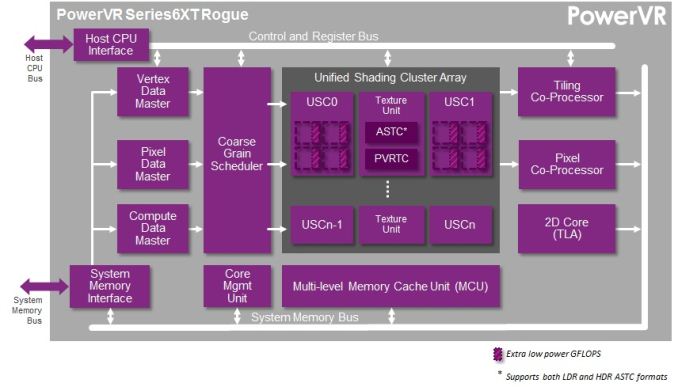
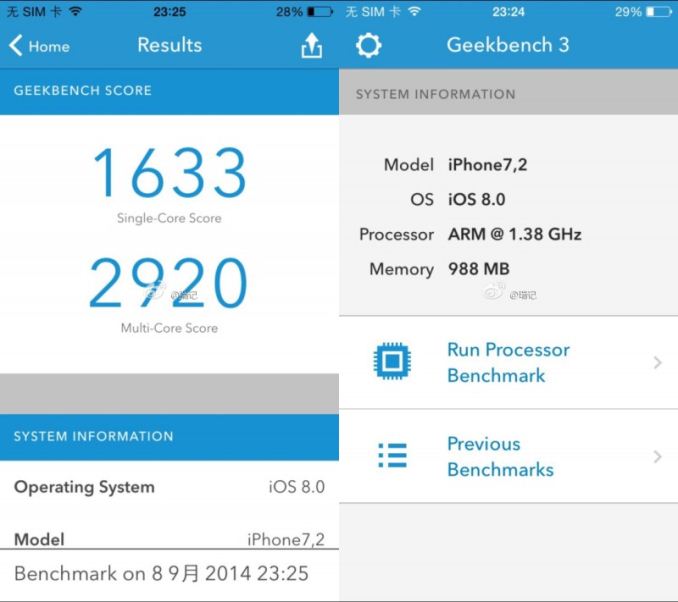
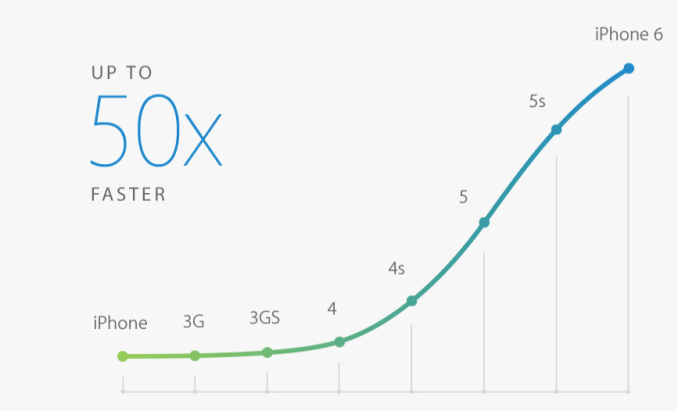








136 Comments
View All Comments
Ryan Smith - Thursday, September 11, 2014 - link
Previously we only live blogged the iPhone announcements because there wasn't a stream. This year there was a stream, so we expected it to be redundant. We did not count on the stream crashing and burning though.lucam - Thursday, September 11, 2014 - link
Dear Anandtech, how can be sure its not the GX6450 GPU? This GPU should 50% quicker than G6430 according to IMG. Not sure about your assumption though.mic-RO - Thursday, September 11, 2014 - link
Does anyone else think there are a lot of unaccounted for transistors on this new die? My thoughts lead me to think there may be some massive new L4 cache lurking in there.errorr - Saturday, September 13, 2014 - link
For all the crap about only 1GB of RAM and being cheap this is my guess too. That kind of density at 20nm takes some really amazing drawing or something really dense like a MASSIVE cache. I think we saw how the A7 used their on die cache to reduce memory access to improve battery life.My guess is that the cost of making the cache far exceeds the cost of additional RAM in a package.
mic-RO - Tuesday, September 16, 2014 - link
I've added up the major segments from the A7's poly silicon images, via Chipworks' die photos, and can account for about 1.4Billion transistors. Assuming that the A8 has a 50% bigger GPU via the GX6650's 2 extra core blocks and a slightly beefier pair of Cyclone cores there is still a lot of transistor real estate to put in a bigger L3 SRAM cache and possibly a L4 cache.Without knowing, or being able to find any openly available details about, the transistor counts of a high end ARM cores I'm just at a loss to figure out what else but a bigger cache (or 2) is lurking withing those >2 Billion transistors.
Haroon90 - Thursday, September 11, 2014 - link
So if it uses half the power yet 25% more cpu and 50% gpu speeds i presume the saved energy is needed to power the bigger higher resolution screens,so where does that leave ipad?Ok i know they are going to make it thinner,perhaps the same as the iphone 6 but the ipad is't getting a screen size increase so doesn't that mean that it's totally feasible to expect there to be a return of the AX ipad chips? I can see no reason for apple not to double the clock on the new ipad air,it's even more needed with the upcoming k1 based nexus 9 coming out next month which is 2.4x as powerful as the a7.
Fingers crossed for a A8X next month,don't let Nvidia take the mobile performance crown Apple!
lucam - Thursday, September 11, 2014 - link
Lol, I like you last sentence! :)Despite I would like to see an A8X too, I don't think the Ipad Air 2 will have a different soc. But there is possibility to have an A8 with higher frequency.
I do expect to have an A8X on the Ipad Pro on 2015 though!
Haroon90 - Thursday, September 11, 2014 - link
Well if they don't put those power savings into making a faster chip then i would expect the ipad air to be extremely thin and light,perhaps even beating the xperia tablet z2...Haroon90 - Thursday, September 11, 2014 - link
Also with each release of the ipad it has also been soc performance wise at the top so it would be strange for apple to release a new ipad with it being underpowered compared to the competition.lucam - Friday, September 12, 2014 - link
Indeed. It did sound strange for me when last year there was no presentation of any A7X. But then thinking back that soc was great (and still it is) for that time being far superior than others around. And also I reckon Apple had invested a lot of resources on A7 and it tried to capitalise this big investment chip in so many devices as it can. Now since the K1, it makes more sense having a powerful soc in the future IpadsNow if for argument sake the A8 has the GX6650, then an A8X which GPU should have? The GX6650 is the top of the PowerVr list. Maybe an high frequency GPU? Otherwise I don't have the clue what GPU could be then.